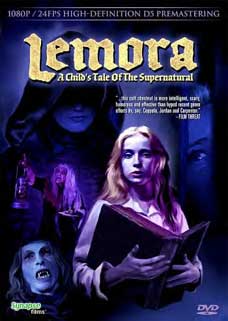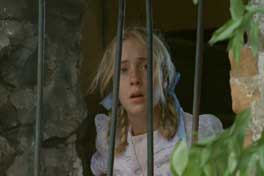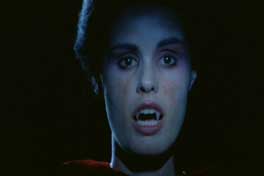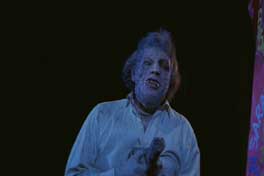 LEMORA,
A CHILD'S TALE OF THE SUPERNATURAL (1973)
LEMORA,
A CHILD'S TALE OF THE SUPERNATURAL (1973)Director: Richard Blackburn
Synapse Films
 LEMORA,
A CHILD'S TALE OF THE SUPERNATURAL (1973)
LEMORA,
A CHILD'S TALE OF THE SUPERNATURAL (1973)Independently
produced and poorly distributed open initial release, LEMORA, A CHILD'S TALE OF
THE SUPERNATURAL is one of the best vampire movies of the 70s, plain and simple.
Director/co-screenwriter/star Richard Blackburn was inspired by the writings of
H.P. Lovecraft, and knowing that COUNT YORGA, VAMPIRE made a killing at the box
office, decided that a vampire movie would be the route to go for his maiden low
budget effort. This was often thought of a "lost" film, but it actually
played frequently on television, at least here in New York in the late 70s and
early 80s (under the chic title LEMORA, LADY DRACULA). I think it wasn't a matter
of it being lost but rather seeing a decent print of the film, and even a semi-official
video release from Moore Video (in the early 90s) didn't do the film justice.
Needless to say, the saga of Lemora can now be viewed in a flawless-looking DVD
released by Synapse Films, and the cliché "never looked better"
has actually ne ver
been more appropriate.
ver
been more appropriate.
Lila Lee (drive-in queen Cheryl Smith, later also known as Rainbeaux Smith) is the 13-year old daughter of butchering gangster, Alvin Lee (William Whitton), who murders her mother and the mother's lover in the opening scene. Reverend Mueller (Blackburn) now takes care of the girl who is a singer in his Baptist church, but she gets a letter from a woman named Lemora (Lesley Gilb) who requests that she comes to her isolated town to see and forgive her dying father. Lila takes off late at night, leaving a letter for the good reverend, and after witnessing the seedier side of town, she eventually boards an empty old bus driven by a creepy eccentric (wonderfully overplayed by Hy Pyke) who takes her to the abnormal town of Asteroth, where Lemora resides. When the bus breaks down in the woods, a number of grotesque beast-like men attack, and Lila eventually makes it to the home of Lemora. First held prisoner by a batty old lady in a nearby shack, the impressionable teen is then welcomed into Lemora's home where she snacks on raw meat, drinks blood from a goblet, and sings before a group of pale, peculiarly dressed children. Lila also forms an unlikely bond with the daunting Lemora, and the monstrous state of her dad is just one of the horrors to be found in her nightmarish journey.
 First-time
director Blackburn and first time producer Richard Fern (both who met at UCLA)
created a dark "fairy tale for adults" that will most likely continue
to attract new fans. Setting the film in backwoods 1930s America was an ambitious
idea, and all the settings are appropriately atmospheric and set a mood not often
seen in films of this sort. At the time that LEMORA was released, the late Cheryl
Smith had already been seen in a number of exploitation-type roles, but she is
very convincing playing a good girl much younger in years, whose innocence is
challenged by the horrors and perversions brought upon her. Leslie Gilb's memorable
vampire queen, with her hair up in a bun, and heavy black wardrobe is somewhat
reminiscent of Gloria Holden in DRACULA'S DAUGHTER. The effective make-up by Byrd
Holland depicts two races of vampires, one who are more civilized (in top hats
and cloaks) and the other hairy and ghoul-like, and the haunting music score by
Dan Neufeld, as well as some unearthly noises on the soundtrack all contribute
to the level of eeriness. LEMORA got by with a PG rating, meaning that in the
days of onscreen excessiveness, its rather mature themes of adolescent sexuality
and religious symbolism where illustrated with subtleness and ambiguity, and it
takes talent to do this successfully. Some may find bits of LEMORA crude or silly,
others (like myself) will find that it has all the right ingredients and know
why it's a million times more momentous than recent Hollywood horse manure such
as VAN HELSING.
First-time
director Blackburn and first time producer Richard Fern (both who met at UCLA)
created a dark "fairy tale for adults" that will most likely continue
to attract new fans. Setting the film in backwoods 1930s America was an ambitious
idea, and all the settings are appropriately atmospheric and set a mood not often
seen in films of this sort. At the time that LEMORA was released, the late Cheryl
Smith had already been seen in a number of exploitation-type roles, but she is
very convincing playing a good girl much younger in years, whose innocence is
challenged by the horrors and perversions brought upon her. Leslie Gilb's memorable
vampire queen, with her hair up in a bun, and heavy black wardrobe is somewhat
reminiscent of Gloria Holden in DRACULA'S DAUGHTER. The effective make-up by Byrd
Holland depicts two races of vampires, one who are more civilized (in top hats
and cloaks) and the other hairy and ghoul-like, and the haunting music score by
Dan Neufeld, as well as some unearthly noises on the soundtrack all contribute
to the level of eeriness. LEMORA got by with a PG rating, meaning that in the
days of onscreen excessiveness, its rather mature themes of adolescent sexuality
and religious symbolism where illustrated with subtleness and ambiguity, and it
takes talent to do this successfully. Some may find bits of LEMORA crude or silly,
others (like myself) will find that it has all the right ingredients and know
why it's a million times more momentous than recent Hollywood horse manure such
as VAN HELSING.
In a new transfer supervised by the director, LEMORA looks absolutely fabulous on DVD, and the years of waiting for a definitive copy has been worth it. Anamorphic and letterboxed at approximately 1.78:1, the color schemes are now striking, making the film even more enjoyable and upping its stylish appearance more than a few notches. Scenes that were often dark and indistinguishable are now clear as can be, and the level of detail is far better than we ever could have imagined. The restoration also delivers the film in perfect shape, as there isn't a noticeable blemish to be found. The Dolby Digital mono track is also impressive, rendering dialog and music very clearly without any apparent background hiss. For anyone who has seen LEMORA in the past, this DVD comes as sort of a revelation.
 Included
is a commentary track with Blackburn, producer Fern and star Gilb. This is a highly
enjoyable track and compliments the film extremely well. The three participants
always share enlightening production information (rather than just watching the
film and repeating what's on screen), take time to ask each other questions, and
share a number of funny anecdotes concerning the cast, the crew and the locations.
There is no moderator here, and frankly, they didn't need one. Also included is
a hefty still gallery with some rare black and white continuity photos, trailers
for some of Synapse's other horror titles and the original, longer shooting script
in PDF format, viewable on your DVD-Rom. The insert booklet contains well-crafted
liner notes by Richard Harland Smith and Chris Poggiali, as well as an appreciative
letter from make-up man Byrd Holland. A highly recommended release!
(George
R. Reis)
Included
is a commentary track with Blackburn, producer Fern and star Gilb. This is a highly
enjoyable track and compliments the film extremely well. The three participants
always share enlightening production information (rather than just watching the
film and repeating what's on screen), take time to ask each other questions, and
share a number of funny anecdotes concerning the cast, the crew and the locations.
There is no moderator here, and frankly, they didn't need one. Also included is
a hefty still gallery with some rare black and white continuity photos, trailers
for some of Synapse's other horror titles and the original, longer shooting script
in PDF format, viewable on your DVD-Rom. The insert booklet contains well-crafted
liner notes by Richard Harland Smith and Chris Poggiali, as well as an appreciative
letter from make-up man Byrd Holland. A highly recommended release!
(George
R. Reis)